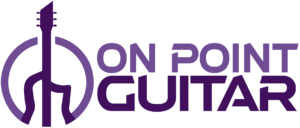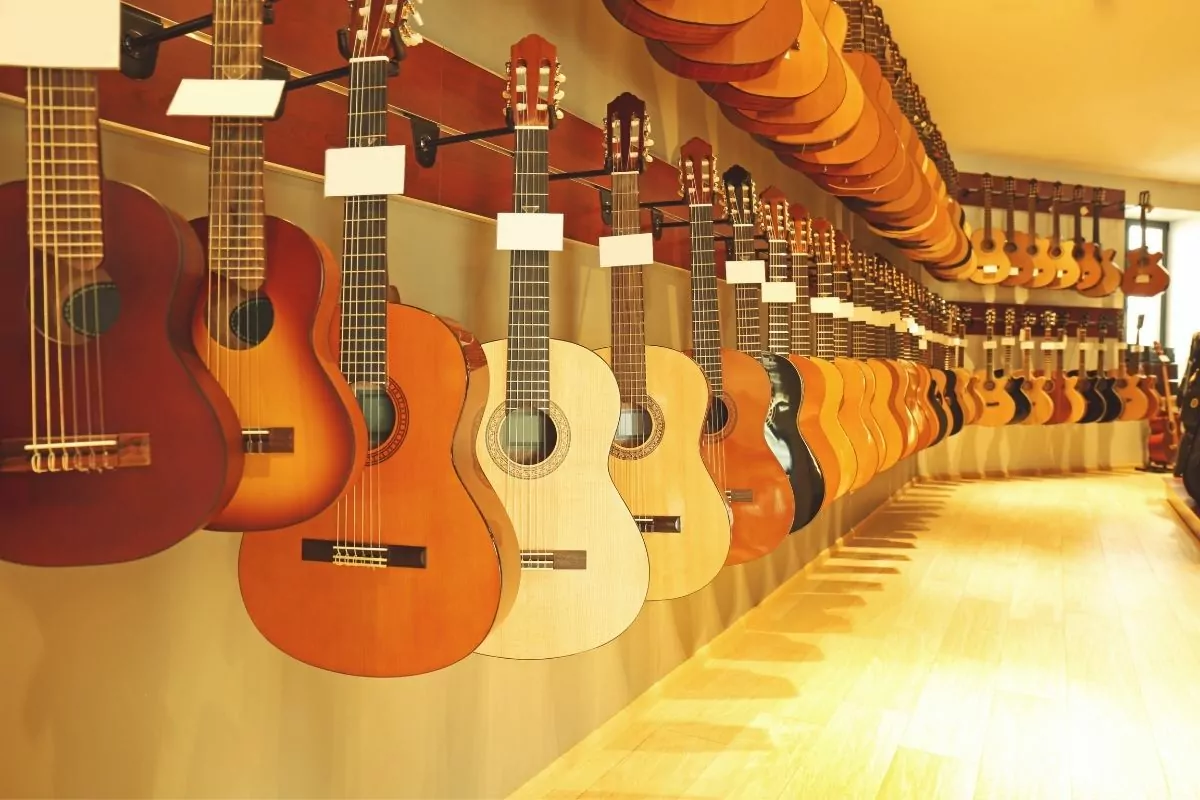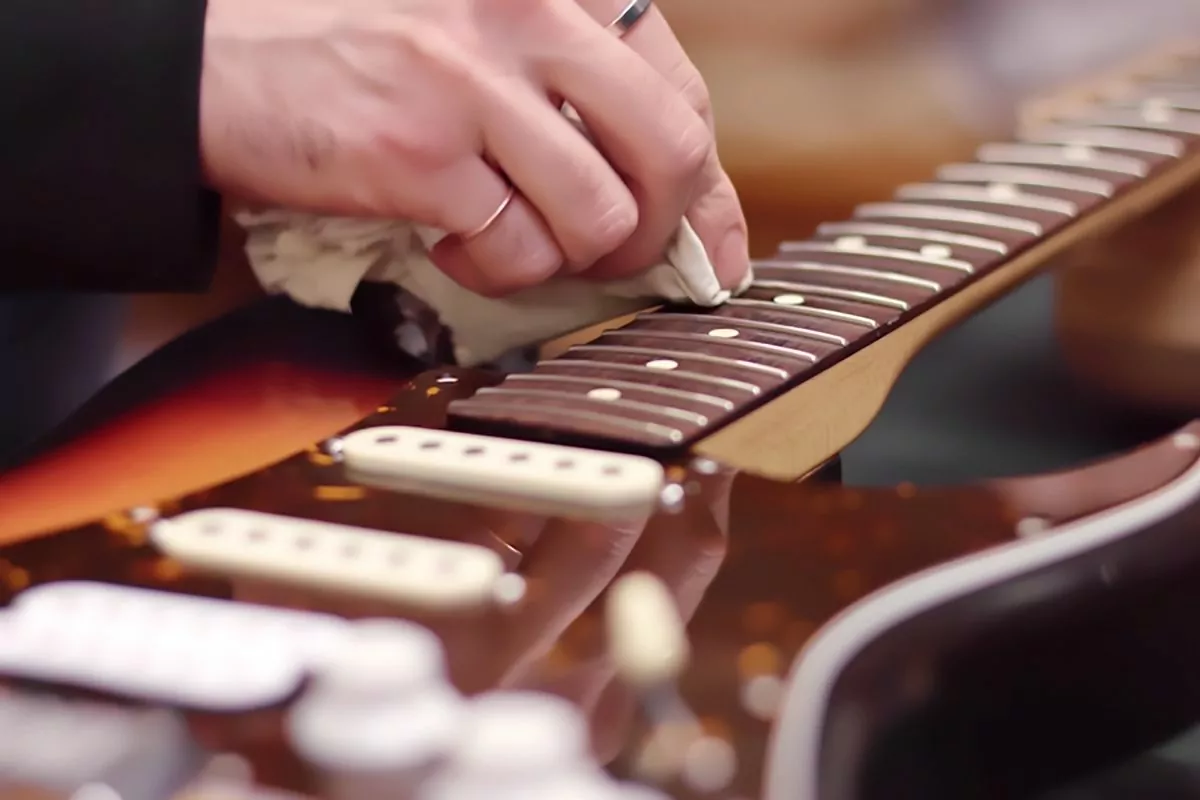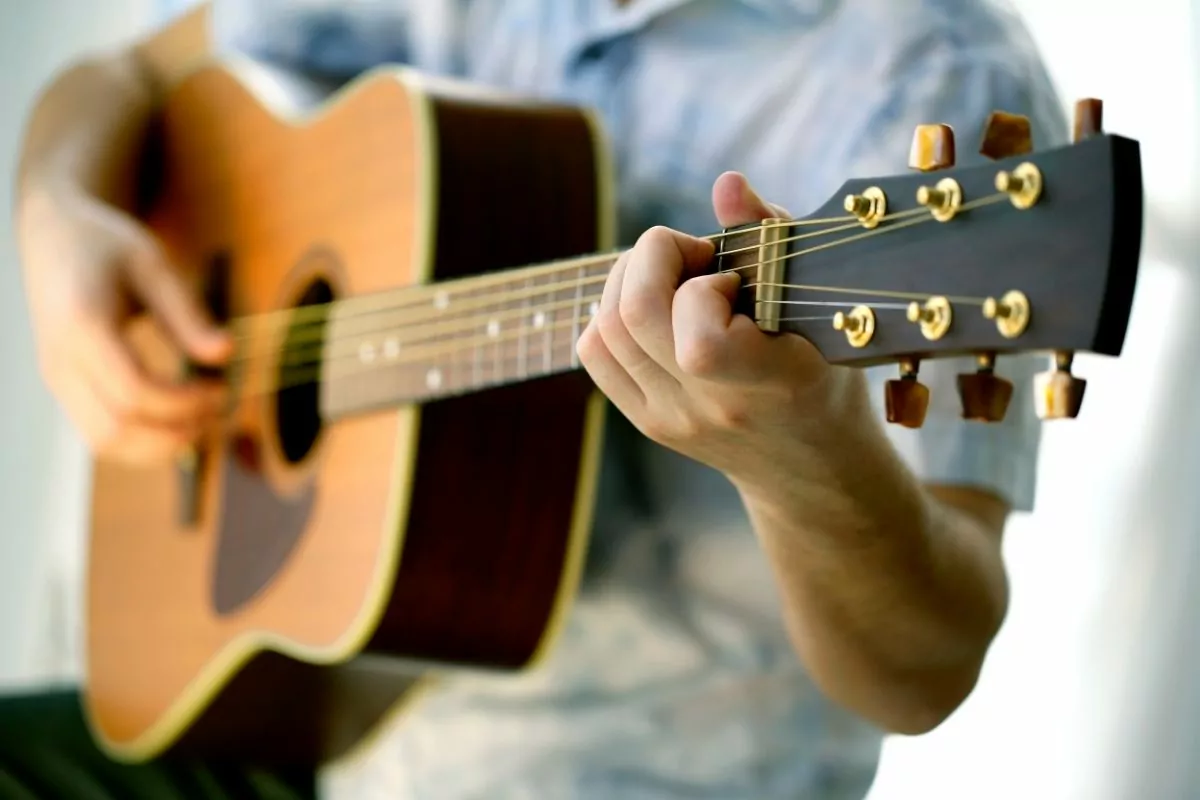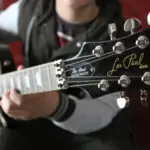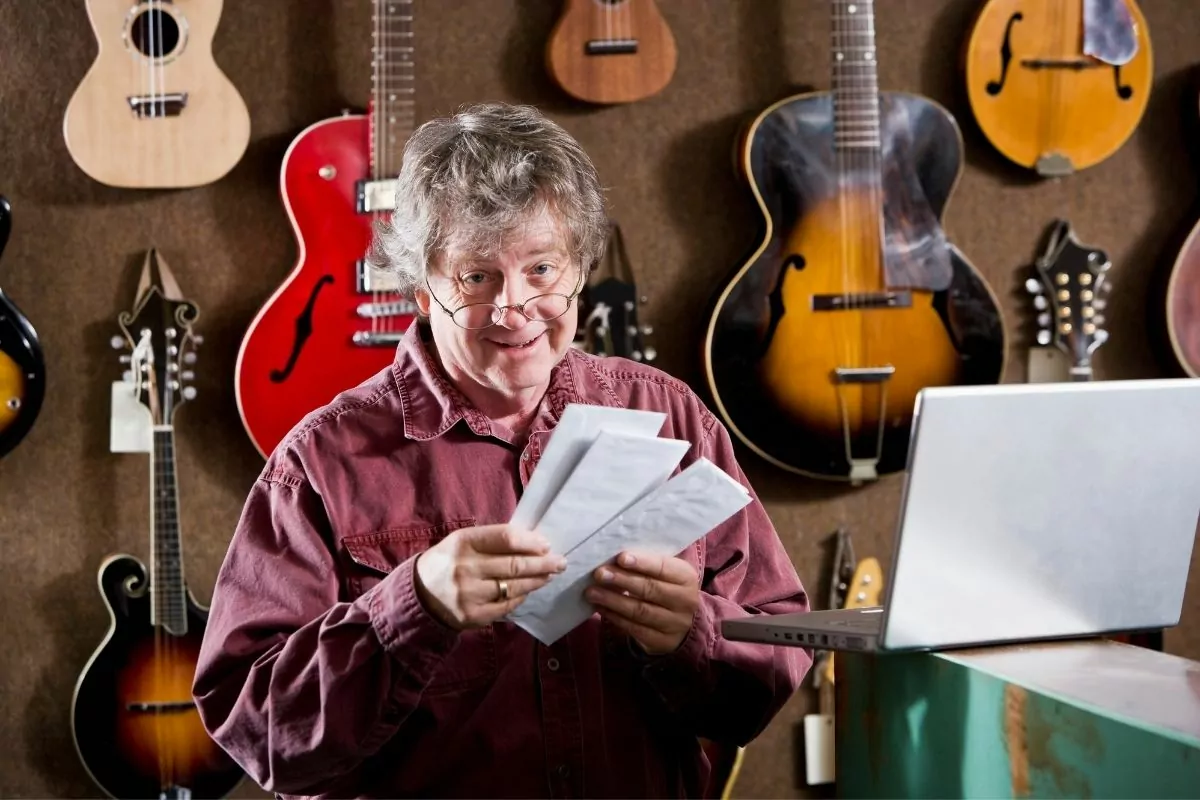As a beginner to the guitar, there is a lot of information to digest. This article covers everything you need to know as a beginner about chords and guitar notes guide.
Guitar notes are easy enough to pick up once you have mastered the basics behind them.

They are the names that we give to the six separate strings of the guitar – yep, each string has its own assigned note (or tone). They all sound different, and you can make different sounds with each string.
When learning any instrument, it’s time to accept that there will be a bit of music theory along the way as well.
The theory is not something to be put off by. The theory is just the cogs behind the songs. It is all the bits and bobs and technical terms that describe how the music works in the way that it does.
It can ultimately help you be a better music player.
Guitar notes guide will focus mainly on standard tuning methods for guitar notes.
Standard Tuning For Guitar String: The Notes
The very first, basic thing to learn about the guitar string notes, is what they are. Every string has a letter, which is its name.
These letters correspond to tones or musical notes. Each string is also a different thickness. The thicker the stringer, the lower the note. As the strings get thinner, the note gets higher.
Every string can be maneuvered to make different notes. But, the six strings of the guitar, generally speaking, are tuned to the same tones across all guitars.
These are:
E
A
D
G
B
E
The first E has a thick string, and is, therefore, a low octave E. The top E has a thinner string and is, therefore, a higher octave E.
For the purposes of this guide, we are focusing on the standard tuning method of the guitar. Other methods of tuning exist, but we are starting with the basics.
Six String Breakdown – Name By Name
—Low E String: The Low E string is the thickest string on the guitar, and the lowest note you can play with standard tuning.
—A String: Next to the Low E String, we have the A String. This is tuned to the A note and is quite a low sound too.
—D String: Up next is the D String. The D String is tuned to the note D. It is slightly thinner than Low E and A.
—G String: The G String is tuned to the note G. It is noticeably thinner than the Low E string, and has a higher pitch.
—B String: The B string is tuned to the B note and is higher still.
—High E String: Last but not least, we have the High E String. This is tuned to a High E note. It is also the thinnest and highest string out of all six strings.
Though, you can play higher notes than a high E with separate finger techniques (discussed later).
How To Remember All These Notes
Learning six different notes can feel somewhat overwhelming. But, don’t fret. There is a really easy, time tested way for you to remember all six guitar string notes. It is called a mnemonic device.
A mnemonic device is just a memory trick. You find a memorable phrase, and it sticks in your brain.
For guitar strings, there are a few common ones that people use. Here are two of the most popular ones.
1. Eddie Ate Dynamite Good Bye Eddie
2. Eat All Day Get Big Easy
These are just a small selection of the many out there. You might even learn them more easily if you create your own mnemonic device.
It’s definitely fun to try. A good tip is to make it silly, or even humorous. A funny thing is more likely to resonate in our minds.
These notes, if the guitar is in standard tuning, apply to all types of guitar.
Guitar Chords Or Guitar Notes: Which Is Better?
What Is A Note?
Guitar notes are singular tones.
Each note has a different pitch and makes a different sound in your ear. These notes come together to make pieces of music.
Each string is one note. When you strum or pluck a string, you are playing a single sound.
What Is A Chord?

Chords are a sequence of notes played in unison. These are normally notes from the same scale, and they sound ‘nice’ when played all together.
Chords are used to create bigger and more dynamic pieces of music and are one of the most popular ways of playing the guitar.
There are a number of essential guitar chords chart that you can learn from different lessons or online tutorials.
It’s fun to experiment with learning different chords and can get your fingers used to playing the guitar. It will take time and practice.
Notes Vs Chords: Which Comes First?
This is all down to personal preference. Everyone learns differently. Everyone has different goals regarding what they want out of their guitar learning experience.
If you want to end up at playing songs, then learning chords is a fast track to doing this. There is no need to learn all the individual notes that you can play on the guitar in order to master chords.
Chords are an entity to themselves when it comes to guitar playing.
It’s probably better to focus on mastering the basics. You need to at least know your way around the raw strings before you try to play chords.
Chords are technical things too, they have names and are bound by the notes that compose them.
So, it’s worth knowing the basic six string structure of standard tuning before diving into chords.
But, that doesn’t mean you have to learn every single note on the guitar and what sound every different finger position makes in order to make progress with your guitar skills.
Why Chords Are Useful
So, we have touched on this a little already. Chords are extremely useful on the guitar. Chords can be a way to master playing songs more quickly.
They can help you learn the notes and the different finger positions on the fretboard more quickly.
They can also give you a greater sense of progress achievement, which will undoubtedly boost your confidence about your playing.
Learning to play chords also builds your stamina base. When you first start to play the guitar, your fingers can suffer as a result. They can get cramps, aches, and even blisters from the strings.
This is because it is creating new muscle memory that is previously untapped. Through playing chords, your confidence, and your stamina grows as well.
Your fingers learn to navigate differently than if you were just focusing on single notes.
Chords can enable you to connect with music on a more intricate level. Learning notes is great and useful. However, there is a different element to the table when you add in chords as well.
Chords can help you feel connected to the song as you are playing along in real time and in a bigger way than just a single line of melody.
You become a part of the bigger picture, and you learn time signatures, which flows into your knowledge grasp of rhythm too.
The Guitar Fretboard
The guitar fretboard is the long strip of wood and metal where the strings lay. It is where your fingers navigate to create chords and different notes.
Essentially, it is the place with which you will have the most contact over your journey as a beginner guitarist. So, let’s take a bit of a deeper dive into some fretboard knowledge.
All About The Musical Alphabet
The musical alphabet is not an alien language. It is the alphabet that makes up all the notes that you will use in your journey as a musician.
It is a list of letters that you learn to enable you to ‘read’ music. Reading music means looking at the notes, recognizing them, and applying that knowledge to your instrument.
When you read a note in a piece of musical sequence, that is the note that you need to play in order to create the desired sound.
The musical alphabet, and all of these notes, collaborate to make a fully formed piece of music, a song, or a shorter instrumental interlude.
You don’t have to learn it, but you will be better off if you do, for a whole bunch of reasons.
The Basic Principles Of The Musical Alphabet

- There are 12 letters.
- It can be written in two different ways.
- It incorporates sharp notes and flat notes.
- An octave is the name given to a sequence of 8 notes – for example, C to C. This would be C B D E F G A B C. Octaves are the segments with which you can build chords and learn scales.
First Written Way
A A# B C C# D D# E F F# G G#
Second Written Way
A Bb B C Db D Eb E F Gb G Ab
All About Sharps And Flats
Conjure up the image in your mind of the piano keys. The white keys are the non sharps and non flats. The black keys are the sharps and flats.
All instruments are capable of playing these sharps and flat tones, and the guitar is no exception. They are an important part of chord formation on the guitar.
And, since they are a part of the musical alphabet, also an essential part of music generally.
Sharps and flats, flats and sharps. Though they have different names, they are highly interchangeable. The difference is in the technicality and the key of the music.
The sign for sharp is #. The sign for a flat is b. If you see these written after a music letter, for example, A#. You know that you need to play the note with a slight alteration.
Now, we say that they are interchangeable because they are. An A# is the same note as a Bb, they are just noted differently and different pieces of music call for different notations.
So running with that theme, a C# is the same note as a Db, and a G# is the same as an Ab.
The rule to remember is that if you see a # sign, the note you’re looking for is slightly above. If you see a b sign, you have a flat, and the note is slightly below. Flatten down, sharpen up. Get it?
The Unalterable Natural Notes
There are some notes in the musical alphabet that do not have sharps or flats. These are notes with no notes in the spaces between each other.
The best example we can give is the note C. There are no sharps or flats notes between a B and a C.
Though you might be tempted to say well technically, a B# is a natural C. It’s not really a language that comes into play with regard to the musical alphabet.
A C note has a sharp, but it doesn’t really have a flat. A B has a flat, but it doesn’t really have a sharp.
The Guitar Notes On The Fretboard

We will start with open strings as our starting point. The first string we will look at is the Low E string. The Low E string, when plucked, produces the note Low E.
How you move between the notes, is by placing fingers on the fretboard. When you place a finger on the fretboard, you create a different note. You can think about this as a change in pitch.
So, by placing one finger on the fretboard on the Low E string, you will create an F note. This is the first fret on the low E string.
The first fret is an F.
The second fret is an F#.
The third fret is a G.
The fourth fret is a G#.
The fifth fret is an A.
The sixth fret is an A#.
The seventh fret is a B.
The eighth fret is a C.
The ninth fret is a C#.
The tenth fret is a D.
The eleventh fret is a D#.
The twelfth and final fret is an E again.
By playing up the fretboard through all twelve fret positions, you have played all the notes that exist between E and the E in the octave above.
This is known as a chromatic scale, aka all 12 notes in the full octave. Not just the 8 scale notes.
Top Tip: Using Those Fret Markers
A fret marker is a dot that you can see marked up and down the fretboard.
These can help you with your finger positioning, and in finding notes and forming chords.
So, if you are ever feeling overwhelmed, or you lose track of what you are playing, lean on fret markers. They can help you regain confidence and find your feet again with the piece of music.
You can normally find these fret markers up and down the fretboard. They are typically on the third, fifth, seventh, ninth, and twelfth frets.
A Technical Interlude
There are a few things, when learning guitar, that you just have to embed into your core memories. The following facts are some that you should carry with you as second nature.
They will make your whole playing experience that much more understandable and smooth.
- What is a whole-step? A whole-step is a space that is two frets wide.
- What is a half step? A half step is a space that is one step wide.
A Whole-Step Example
A and B have two fret spaces between them. Therefore, there is a whole-step between note A and note B.
This is also true of C and D. It is also true of F and G. And, finally, there are also two fret spaces between G and A.
You may have clicked that these whole-step notes have sharps and flats between them. This is relevant for our next example.
A Half-Step Example
There is one fret space, and therefore a half-step between note B and note C.
The other example of a one fret space (half-step) is note E and note F.
This is because there are no sharp and flat named notes between these tones.
We have already touched base with our ‘natural’ notes. Just to recap a little, natural notes are ones that do not have a sharp or a flat symbol attached.
Practice Time: Find The Natural Notes

Okay, so we can talk and talk and talk. But, there’s more to guitar playing than learning all the ins and outs of the notes. You have to also apply that knowledge to the instrument.
Sometimes, it doesn’t click fully until you’ve actually put your finger to the fretboard, so to speak. You can read all you like, but now it’s time to actually try.
Start on your Low E string. This is a natural note.
Firstly, you have to remember which natural note comes after E in the musical alphabet.
The answer is F.
Secondly, you have to remember whether there is a whole-step or a half-step between an E note and an F note.
This is important, because if you go whole step instead of a half-step or a half-step instead of the whole step, you may end up with a sharp or a flat instead of a natural note.
So, if you remember, the answer is there is a half-step between a natural E note and the natural F note. Therefore, you are only going to be moving up one fret space.
After this, it’s a G note as the next natural note.
We know, from what we’ve already learned, that there is a two fret space between these natural notes because F#/Gb exists in the half-step realm.
So, you are going to have to move two fret spaces, or a whole step, in order to find that natural G.
Sticking with it so far? Great. Keep going until you have managed to find an entire octave.
You don’t have to stick with the Low E string. Feel free to experiment with all the natural notes up and down the strings of the guitar. You will find there is a lot to play with.
Practice Time: Find The Sharps And Flats
After playing around and finding all the natural notes your heart desires, the next focus should be on finding and figuring out those sharps and flats.
This is just gap filling now that you’ve got the hang of the naturals.
A good method is to retrace your steps. Where you had a whole step, this becomes a half-step, and voilà! You have your sharp or your flat, whichever way that you’re looking at it.
You can practice a few of the chromatic scales that we were discussing previously. This is a good way of helping you get used to finding the correct tones for all the natural notes and the sharps and the flats.
Practicing In BiteSize Sessions
There is no denying the fact that practice is the only way to get better at guitar playing. The same is true of any skill. It takes time, it takes effort, it takes motivation.
But we will say that even a five-minute practice is better than no practice at all. If all you can face is picking up your guitar and plucking the strings up and down the fretboard, then that is fine.
Well done. Every time you pick up your guitar, your skill base increases.
So, we are asking you to practice. As a beginner, you have a lot of new information to absorb. Maybe you already have a musical background, and maybe you don’t.
People may feel they have an advantage with prior musical theory knowledge, and they can certainly cut some corners when it comes to absorbing the information about the guitar.
However, there is guitar specific knowledge that you can apply to your practical playing regardless of your musical background.
So, whatever time of day suits you, pick up that guitar and practice. Here are a few small practice things that you could try to get the ball rolling.
1. Low E String
Okay, so we experimented above with the Low E string and with finding all the natural notes. You can do this until you feel confident and comfortable.
It will take a while for your fingers to get used to the feel and sense of the strings, but they will get there.
It becomes like a memory foam type relationship over time. Take your time to go up and down the Low E string, figuring out all the sharps and flats until you don’t even have to think about it consciously anymore.
2. Specific Note Jumps
As we’ve seen already, some notes require a half-step and some require a whole step. You could take your time and learn what’s what.
You have experimented with the Low E string, but what about the A string?
What is the step between an A note and a B note? Well, that’s up to you to experiment and find out. Again, you don’t have to spend hours on this exercise.
In fact, we recommend smaller bursts of activity a few times a day or as often as you can face.
There is little point in overwhelming yourself with too much new knowledge, that’s for sure.
FAQ
Do All Guitar Notes Have a Sharp or Flat?
While there are sharps or flats in notes, it’s important to note that not all notes have a sharp or a flat. In reality, B#/Cb or E#/Fb doesn’t exist.
For instance, in the below sequence, you will see that;
A, A#, B, C, C#, D, D#, E, F, F#, G, G#, A
From the above example, it’s clear that B to C and E to F does not have a sharp or a flat.
Will Putting Stickers on a Fretboard Help Me Learn The Notes Faster?
Unsurprisingly, putting stickers on your fretboard might fasten your learning process. This is an excellent memorization strategy if you are struggling with remembering the notes at the top of your head.
Conclusion – Guitar Notes Guide
Regardless of the type of learner you class yourself to be, the guitar has a technical skill set alongside the theoretical stuff.
Getting to know the notes when you are a beginner of any instrument, the guitar included, is a smart way to kick-start the learning process.
If you know the notes, and you know them inside and out, then you will feel more confident further down the line when it comes to playing songs and even collaborating with other musicians in different musical settings.
So, by learning those notes and practicing those finger positions along the fretboard, all you are doing is boosting your confidence as a player and your overall skill set as a musician.
If you enjoyed this article, you might enjoy our post on ‘Where Are Gretsch Guitars Made?‘.

My name is Howard Matthews and I have been playing the guitar since I was knee-high. My parents like to joke that I was pulling the strings even before I was born. In fact, one of my earliest memories is sitting on the couch with my dad’s guitar, wreaking havoc on the chords.
Now, 40 years later, I can attest that I play them much better than I did back then. I have followed in the footsteps of both my parents – much to their delight – and have been the main guitarist in my band for the best part of three decades.
Music has always been my passion, and until recently my life has been so consumed with it that I haven’t had a moment to have a breath (and I wouldn’t have it any other way)!
